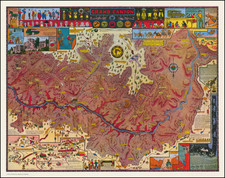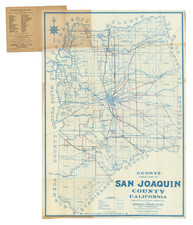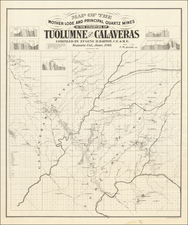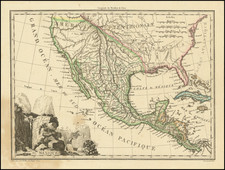The Only Surviving Example of This Detailed Map of the Central Pacific Railroad Showing the Completed Route from Sacramento to the Nevada Border.
Detailed map of California, Nevada and Utah, focusing on the proposed route of the Central Pacific Railroad.
The map shows the completed route of the Central Pacific Rail Road from Sacramento to Truckee River, and the projected route from the Truckee River to Salt Lake City.
The map extends east to about the eastern border of Utah; and north-south about 42.5º to 36.5º. This map is drawn from a section of Bancroft's "Map of the Pacific States", with Bancroft's copyright notice. Colton did not have such a large scale map which may be why he borrowed it.
Streeter describes the map as follows:
The title of this map is not fully descriptive, for the route of the Central Pacific is shown not only to the Big Bend of the Truckee, but all the way into Salt Lake City, the route - as with my 1864 Bancroft map and other early maps - going south of Great Salt Lake. The route is shown as finished to east of Donner Lake indicating a later date in 1865 for this map... No terminus west of Sacramento is indicated. Though the 1864 Bancroft map is followed for the route of the Central Pacific, Bancroft's incorrect showing of San Francisco and Marysville is not repeated here. The map continues to the eastern border of Utah and goes as far south as the parallel of Monterey."
The map is an exceptional rarity. The title of the map suggests that it was inspired in some way by Theodore Judah's Map of the "designated route" of the Central Pacific R.R. of California: showing its general location from the city of Sacramento to eastern boundary of Cala., and to Big Bend of Truckee, a copy of which survives only in facsimile.
The present example is the Warren Heckrotte copy, acquired from Florian Shasky in 1984. Prior to this example, the only known example was the Thomas Streeter Copy, sold as #2894 in his sale of Western Americana in the 1960s. We surmise that this is quite likely the same example of the map as was offered in the Streeter Sale.
G. W. & C. B. Colton was a prominent family firm of mapmakers who were leaders in the American map trade in the nineteenth century. Its founder, Joseph Hutchins Colton (1800-1893), was a Massachusetts native. Colton did not start in the map trade; rather, he worked in a general store from 1816 to 1829 and then as a night clerk at the United States Post Office in Hartford, Connecticut. By 1830, he was in New York City, where he set up his publishing business a year later.
The first printed item with his imprint is dated 1833, a reprint of S. Stiles & Company’s edition of David Burr’s map of the state of New York. He also printed John Disturnell’s map of New York City in 1833. Colton’s next cartographic venture was in 1835, when he acquired the rights to John Farmer’s seminal maps of Michigan and Wisconsin. Another early and important Colton work is his Topographical Map of the City and County of New York and the Adjacent Country (1836). In 1839, Colton began issuing the Western Tourist and Emigrant’s Guide, which was originally issued by J. Calvin Smith.
During this first decade, Colton did not have a resident map engraver; he relied upon copyrights purchased from other map makers, most often S. Stiles & Company, and later Stiles, Sherman & Smith. Smith was a charter member of the American Geographical and Statistical Society, as was John Disturnell. This connection would bear fruit for Colton during the early period in his career, helping him to acquire the rights to several important maps. By 1850, the Colton firm was one of the primary publishers of guidebooks and immigrant and railroad maps, known for the high-quality steel plate engravings with decorative borders and hand watercolors.
In 1846, Colton published Colton’s Map of the United States of America, British Possessions . . . his first venture into the wall map business. This work would be issued until 1884 and was the first of several successful wall maps issued by the firm, including collaborative works with D.G. Johnson. From the 1840s to 1855, the firm focused on the production of railroad maps. Later, it published a number of Civil War maps.
In 1855, Colton finally issued his first atlas, Colton’s Atlas of the World, issued in two volumes in 1855 and 1856. In 1857 the work was reduced to a single volume under the title of Colton’s General Atlas, which was published in largely the same format until 1888. It is in this work that George Woolworth (G. W.) Colton’s name appears for the first time.
Born in 1827 and lacking formal training as a mapmaker, G. W. joined his father’s business and would later help it to thrive. His brother Charles B. (C. B.) Colton would also join the firm. Beginning in 1859, the General Atlas gives credit to Johnson & Browning, a credit which disappears after 1860, when Johnson & Browning launched their own atlas venture, Johnson’s New Illustrated (Steel Plate) Family Atlas, which bears Colton’s name as the publisher in the 1860 and 1861 editions.
J.H. Colton also published a number of smaller atlases and school geographies, including his Atlas of America (1854-56), his Illustrated Cabinet Atlas (1859), Colton’s Condensed Cabinet Atlas of Descriptive Geography (1864) and Colton’s Quarto Atlas of the World (1865). From 1850 to the early 1890s, the firm also published several school atlases and pocket maps. The firm continued until the late 1890s, when it merged with a competitor and then ceased to trade under the name Colton.













![Map of Mexico, Central America, and the West Indies [Insets of Bermuda, Cuba, Jamaica and Panama Railroad]](https://storage.googleapis.com/raremaps/img/small/70686.jpg)
![[California and Nevada] (Names Bigler Lake or Tahoe)](https://storage.googleapis.com/raremaps/img/small/94197.jpg)